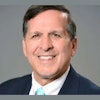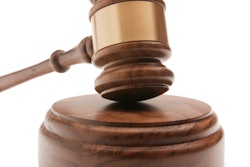
A 66-year-old woman contacted a cosmetic and restorative dentist for an exam, x-rays, and a cleaning, as well as to establish a relationship with a dentist near her new home. This patient had completed maxillary restorative work in the past, including fixed bridges, individual crowns, and endodontic therapy.
Most of this work had been in place for at least 20 years, and the patient was unhappy with the aesthetic look of her teeth and mouth. Her lower teeth were heavily restored with fillings but were otherwise intact and stable. The patient's periodontal condition was reasonably stable despite only adequate hygiene.
On the initial visit, the dentist spent a good deal of time with the patient, explaining all the clinical and radiographic findings and providing treatment options. Most significant was the fact that many of the maxillary crowns, including bridge abutments that supported pontics, had open margins with decay beneath the crowns.

The dentist concluded that all the existing prosthetics required removal. The patient fully understood and accepted that proposition. However, there was a question as to whether new bridges would be fabricated with the teeth that existed or whether the missing teeth would be replaced with implants on which the restorations would be made.
The dentist suggested that the patient consult with an oral surgeon, who would place the implants, so the patient would have as much information as possible before making her choice.
After meeting with the oral surgeon, the patient elected to have implants placed. The dentist consulted with the oral surgeon to arrive at the most appropriate approach, after which the dentist removed the crowns and bridges, reprepared the teeth, and fabricated a lab-processed provisional so that the patient could function during the implant healing period.
Following an uncomplicated set of implant-related steps, the dentist fabricated individual crowns on both the maxillary implants and natural teeth, extending from the first molar on the right to the second molar on the left.
It should be noted that the patient repeatedly complained that she did not like the cosmetic appearance and the "feel of the bite." The dentist returned the crowns to the lab to make the cosmetic corrections requested by the patient multiple times, and the dentist also made numerous occlusal adjustments.
During some of these visits, the patient began to become aggressive and loud toward the dentist and her staff, including in the waiting room in front of other patients. Both the dentist and a dental assistant made notations in the patient chart, describing the inappropriate behavior of the patient over the course of several visits.
At the final visit, with all of the newly made crowns in place in the mouth, without cement, the patient continued with her complaints. Using various means of assessing occlusion, the dentist could not find any discrepancies warranting any further adjustments, and she fully explained that to the patient.
But the patient refused to accept the aesthetics and demanded changes. The dentist suggested starting the whole process again, putting back the provisionals and having the lab remake everything. The patient had an out-of-town wedding to attend the following week, and she pushed her way out of the chair, walked to the reception desk, and began screaming and throwing magazines and other items at the staff and other patients. The dentist called the police to have the patient removed.
That day, the dentist sent the patient a letter severing their relationship, advising her that she must seek other dental attention as soon as possible and offering her own services for 30 days in the event of an emergency.
Legal stance
The patient retained an attorney, who filed suit against the dentist, claiming dental malpractice by virtue of her having placed crowns that were aesthetically unsatisfactory, occlusally unstable, and "unfinished." She also claimed abandonment.
Issues raised
Two issues were raised during the legal process:
- The failure to place crowns of acceptable quality: While crowns must be acceptable according to professional standards in terms of marginal integrity, occlusal balance, interproximal contact, and adequate interdental space, the concept of aesthetics is entirely subjective and ultimately in the "eye of the beholder." However, those standards are applicable to the finished product, although a question exists -- at least potentially to lay jurors -- as to how long the process should take to get to that point.
- Patient abandonment: Although the definition may change between states, this concept basically states that abandonment is the unilateral termination of a dentist-patient relationship by the dentist, without adequate notice, while there is a continuing need for dental work.
Preparation for trial
In the lead-up to the trial, both sides disclosed their respective experts' credentials and the substance of their anticipated testimony. We disclosed a prosthodontist who would testify, on the issue of malpractice, that the dentist's treatment was a work-in-progress as of the final visit, that the dentist made every possible accommodation for the patient in terms of trying to meet her aesthetic desires, that the marginal integrity and all other functional aspects of the crowns were, according to his examination of the patient during the litigation, all proper, even though not cemented, and that there were no perceivable occlusal discrepancies.
As to the abandonment issue, the expert would say that, given the patient's totally unacceptable office behavior, the dentist's willingness to continue to try to please the patient, and the 30-day availability period, there was more than adequate basis for the relationship severance and appropriate notice in terms of telling the patient what she should do and the dentist's availability for emergencies.
The plaintiff disclosed an expert who was a periodontist, who regularly did implants but who had not placed crowns for more than 20 years. The plaintiff would not call as an expert witness the restorative dentist she subsequently saw but who did no treatment (for reasons unbeknown to us).
The periodontist would testify that the repeated need to send the crowns back to the lab could only be indicative of improper tooth preparation -- which, incidentally, this dentist did not check when he examined the patient during litigation because the patient would not allow him to remove the crowns -- and that, because occlusal comfort cannot be verified by anyone other than the patient, deference must be given to her that her discomfort meant an improper bite.
His view on abandonment was that once the dentist had accepted full payment of her fees, she was obligated to treat the patient under any circumstances, unless and until the patient said otherwise.
Trial
The patient testified at trial, often giving the jury and judge clear examples of what must have happened in the office during the final visit tirade. She explained her dissatisfactions and spoke of her subsequent visit with another dentist, but because she did not bring him in as a witness, hearsay rules forbade any description of that dentist's findings and suggestions.
The defendant dentist told the jury why she performed the dentistry she did, the choices made by the patient, her attempts to make the patient's desired changes (even though she saw no dentally inappropriate reason for the complaints), and the end-of-treatment events.
When the plaintiff's expert testified, he criticized the crown preparations of the dentist, despite the fact that he never visualized them, and claimed that they caused the problems in fabricating crowns that were cosmetically and functionally acceptable.
On cross-examination, he admitted to his not having made a single crown for more than 20 years, and further admitted that his conclusion that the preparations had to have been improper -- because of the patient's ultimate dissatisfaction -- was speculative, given that he had no first-hand knowledge about them but had simply worked backward from the end result. His testimony about abandonment was as anticipated and as described above.
Upon our motion, without having yet brought in the prosthodontist on behalf of the defendant, the judge granted what is known as a directed verdict on behalf of the defendant, taking the case out of the hands of the jury.
The basis for the judge's ruling was twofold:
- Abandonment's elements had not been met because, even if the dentist had improperly ended the relationship, she gave the patient swift and adequate notice of doing so, and made herself available for emergencies for a reasonable time. The judge also wondered aloud whether any professional should be forced to continue a relationship with an ongoing pattern of behavior culminating in the need for police intervention.
- Simply because the patient and her expert did not like the end result does not constitute malpractice and does not mean that the result must have been caused by improper treatment, which could not be verified by the expert but was, instead, only speculated about.
Practice tips
“There is no substitute for contemporaneous documentation of everything from clinical situations.”
- Documentation: As we have written in the past, there is no substitute for contemporaneous documentation of everything from clinical situations -- especially if they demonstrate a problem -- to inappropriate patient behavior. It is our view that even if the judge had allowed the case to be decided by the jury, jurors would have held against the plaintiff the fact that her behavior in the dental office was improper, to say the least, making her an unworthy recipient of money from a verdict. If the dentist had not documented but rather just testified about it without having written about the events when they happened, it would have made her far less credible.
- Aim to please: Although this patient was overly demanding and difficult in many respects, this dentist followed every proverbial rule of risk management by doing everything in her power to make the patient feel heard and to try to keep her happy. Even though the relationship turned quite sour at the end in this case, juries on malpractice cases, in general, want to see that the professional respected the patient and tried hard to make things right.
- Patient abandonment: When discharging a patient from the practice, particularly if the treatment has not been completed, it is important to comply with any state board rules. Please check with your state's dental association, dental board, or both. That said, we suggest the following:
- Write a gently worded letter ending the doctor-patient relationship.
- Briefly provide a reason such as a breakdown in communication and/or the doctor-patient relationship.
- Offer to be available for emergencies for 30 days.
- Set forth the importance of continuing to seek treatment and why.
- If the treatment is not finished or certain problems are anticipated, put the patient on notice.
- Offer to provide the patient's chart/films per local state board rules.
There is no perfect discharge letter, so ask yourself how you would view it if you were a juror. Does it sound fair and reasonable, or does it sound like you are abandoning the patient midtreatment in a callous fashion? Seek the former.
William S. Spiegel, Esq., is a partner at the law firm Spiegel Leffler in New York City. He is a former assistant corporation counsel to the City of New York -- Medical Malpractice Division.
Marc R. Leffler, DDS, Esq., is also a partner at Spiegel Leffler. He received his dental degree from Columbia University, completed a residency in oral and maxillofacial surgery at New York University, and is a diplomate of the American Board of Oral and Maxillofacial Surgery.
Disclaimer: Nothing contained in this column is intended as legal advice. Our practice is focused in the state of New York, and there are variations in rules of practice, evidence, and procedure among the states. This column scratches the surface on many legal issues that could call for a chapter unto themselves. Some of the facts and other case information have been changed to protect the privacy of actual parties.
The comments and observations expressed herein do not necessarily reflect the opinions of DrBicuspid.com, nor should they be construed as an endorsement or admonishment of any particular idea, vendor, or organization.



















